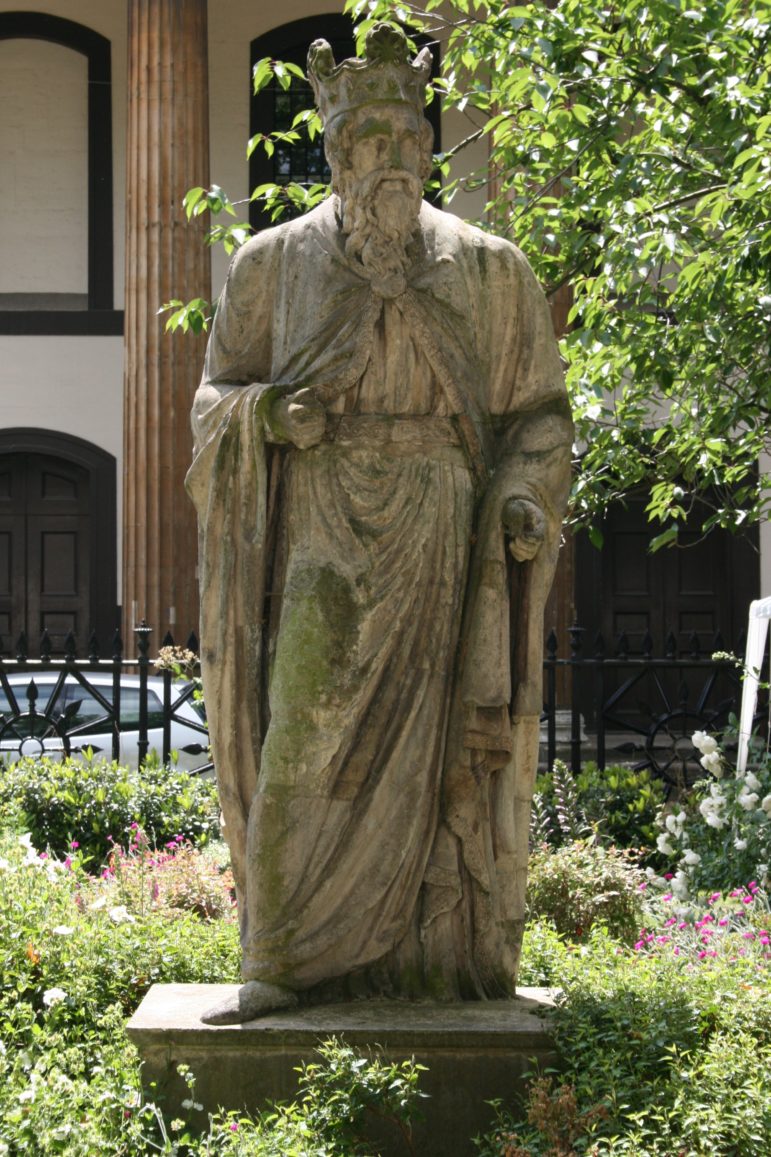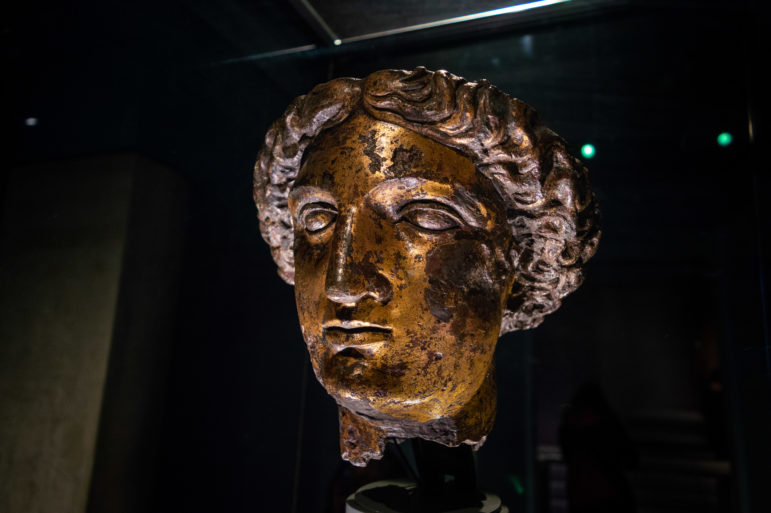LONDON – The British public were startled to learn this week that a longstanding statue of King Alfred, which has stood in the grounds of Trinity Church in Southwark since 1826, has been revealed to have an unusual feature: the skirts of his robe do not belong to King Alfred at all, but to the Roman goddess Minerva.

Trinity Church Square Statue of King Alfred – Image credit: Paul Simpson – CC BY 2.0
The statue itself has puzzled experts for some time. It has believed to have been an 18th-19th century carving in the style of a 14th century work, perhaps in the style of one of the statues that used to stand in Westminster and which were originally commissioned for Richard II.
To investigate further, conservation work was conducted on the statue in early 2021 and it was discovered that the work is not one statue, but two. Moreover, King Alfred has women’s legs. A further mystery was thus initiated: who did the lower half of the statue originally belong to?
The investigation was carried out by London Stone Conservation, with the £16,500 cost funded by the Heritage of London Trust and the Corporation of Trinity House (the statue stands in a private garden but can be seen from the road).
Those performing the restoration found that the upper part of the statue, featuring King Alfred’s bearded face, his clasped robe and a belt, are made of artificial Coade stone, whereas the bottom half of the statue is made of a completely different type of material, namely Bath stone.
Roman art specialist Professor Martin Henig believes that the lower half of the statue was made by a stonemason from somewhere in Europe, but using British materials. He estimates that this portion of the statue dates from Roman Emperor Hadrian’s day, around 2nd-century C.E.
Judging from the dimensions of this part of the statue, the original would have been around 3 metres tall: a significantly large piece which Professor Henig says would have been one of the largest found in the U.K. to date.
Alfred is one of England’s best-known kings: a literate and scholarly ruler, who deserves to be famous for more than his cakes. Ruler of the West Saxons in the 800s, he defeated the Vikings in the south and with them, created the Danelaw.
He undertook a large number of administrative reforms during his rule, including education in Old English rather than Latin. He was not a pagan, but a Christian king, and accompanied his father on a pilgrimage to Rome.
The lower half of his statue is of course a very different person: the goddess Minerva herself.
We know that Minerva was worshipped throughout southern Britain under the Roman occupation – the city of Bath was home to the syncretic cult of Sulis Minerva, in which worship of the Roman deity was joined to that of the British goddess Sulis, a deity of the hot springs on which Bath was founded and which are still found at the centre of the city today.

Bronze head of Sulis Minerva at Roman Baths – Image credit: Tristan Surtel – CC BY-SA 4.0
Sulis appears to have been a healing goddess, associated with the elements of water and fire, and joined to Minerva, who was a goddess of war, wisdom and the crafts, the syncretised entity would have been a powerful one. But Minerva’s worship was not confined to Bath.
Carpenters throughout Britain placed her image on their tools and she was also worshipped in Carrawburgh, up near Hadrian’s Wall. There are traces of her in London and the recent discovery will add a new dimension to what we know of her worship in London. Whether her statue was brought to the capital from Bath remains to be seen.
Obviously, the statue does not represent any kind of joint entity: Alfred was not a god. This is an example of a sculptor with an eye for using existing resources.
TWH asked the UK’s pagan community for its views:
Esoteric writer Caroline Wise, said, “It is a shame that the statue of King Alfred – and its newly discovered ‘Monumental Minerva’ base, is not on public display. It stands by a church (now redundant) so there is perhaps a continuation of sacred usage of the site.”
She continued, “I like the synchronicity that it lies in what is now Trinity Church Gardens as Minerva formed a trinity with the major gods Jupiter and Juno, known as the Capitoline Triad. They had a major role in the Roman religious world. Plenty of old gods have revealed themselves in Southwark since the turn of the 20th century and it is great that they continue to do so with Minerva. In Tabbard Square, two round temples were discovered, with one clearly dedicated to Mars Camulus – a horned Mars joined with the Gaulic Camulus. The temples are now under social housing. Others include Isis, whose temple was here, Anubis, ‘Genius’, ‘The Hunter God’, who is possibly Apollo or Mithras, and Matronae.”
Wise went on to point out, “There is a rich ritual landscape below Southwark, which was once a group of eyots. Its position in and by the water may have been significant both spiritually and practically, and the river was wider and shallower here. There were Neolithic platforms and trackways. Some think the former were for ritual use, but they could just have been jetties for boats or for fishing, but they’d still need their gods with them!”
“There is something very Graham Chapman and Monty Python about this!” Gavin Bone, Wiccan, commented.
* * *
Bronze Age Axe hoards and Roman mosaics
Lockdown in the U.K. and its immediate aftermath has been kind to detectorists and amateur archaeologists, with a Roman mosaic discovered on the property of a farmer in Rutland, and the unearthing of a cache of Bronze Age axes by a 13-year-old girl in Hertfordshire.
Milly Hardwick was only on her third outing with a metal detector when she discovered first a single axe, then a further 65 artefacts. Milly and her father called in a team of professional archaeologists when they realised what they’d found and the hoard will be sent to the British Museum.
In Rutland, the landowner’s son Jim Irvine was out for a lockdown walk on the family property in 2020 when he noticed some unusual pottery. He dug a trench, and realised that the fragments were part of a larger mosaic, so contacted his local museum.
When further investigations took place, archaeologists realised that the site was part of an entire Roman villa, belonging to a wealthy person and then forgotten over the intervening centuries. Historic England gave funding to the University of Leicester to conduct a dig, revealing the dining room floor of the villa.
The mosaic shows Hector in battle with Achilles at the climax of the Trojan War – whoever commissioned the mosaic had knowledge of classical literature. Barns, other outhouse buildings and possibly a bathhouse surround the villa itself.
Duncan Wilson, chief executive of Historic England, added: “To have uncovered such a rare mosaic of this size, as well as a surrounding villa, is remarkable. Discoveries like this are so important in helping us piece together our shared history. By protecting this site we are able to continue learning from it, and look forward to what future excavations may teach us about the people who lived there over 1,500 years ago.”
The site is not open to the public but the fields in which it is placed will no longer be used for farming: a full archaeological investigation is now ongoing.
The Wild Hunt is not responsible for links to external content.
To join a conversation on this post:
Visit our The Wild Hunt subreddit! Point your favorite browser to https://www.reddit.com/r/The_Wild_Hunt_News/, then click “JOIN”. Make sure to click the bell, too, to be notified of new articles posted to our subreddit.